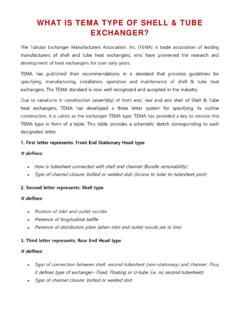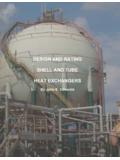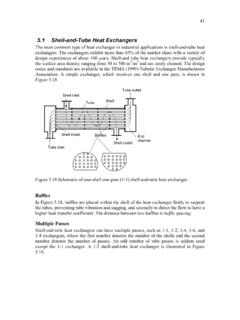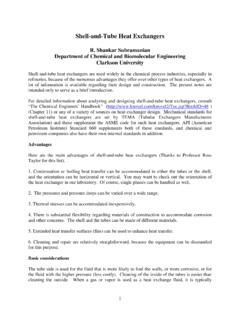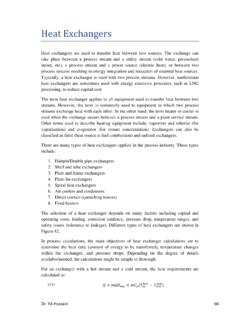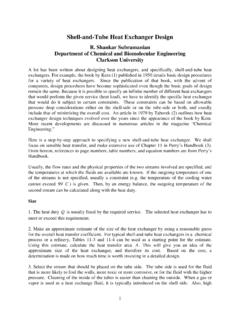Transcription of TYPES OF SHELL & TUBE HEAT EXCHANGERS
1 TYPES OF SHELL & TUBE heat EXCHANGERS The choice of heat exchanger type is done based on following considerations i. Differential thermal expansion between tubes and SHELL ii. Ease of maintenance and servicing o Full diameter channel opening, enabling access to TTJ o Removable bundle, enabling SHELL side cleaning or bundle replacement iii. Cost There are three main TYPES of SHELL & Tube heat EXCHANGERS Fixed tubesheet exchanger Floating tubesheet exchanger U tube exchanger 1. F I X E D T U B E S H E E T H E A T E X C H A N G E R S Figure 1: TEMA type BEM Figure 2 : TEMA type NEN - A fixed-tubesheet heat exchanger has straight tubes that are secured at both ends to the tubesheets welded to the SHELL . - Following three TEMA TYPES of fixed-tubesheet heat EXCHANGERS can be made i. AEL: Removable channel covers ii.
2 BEM: Bonnet-type channel covers iii. NEN: Integral tubesheets These are commonly used in high pressure services. - They are the least expensive type because of its simple construction, as long as no expansion joint is required. - Fixed type tubesheet designs are most vulnerable to differential thermal expansion since there is no inherent provision to absorb the thermal stresses. To overcome these stresses, fixed tubesheet heat EXCHANGERS are generally equipped with an expansion joint. - Fixed head heat EXCHANGERS are designed to handle temperature differentials up to 100 C. Thermal expansion prevents a fixed head heat exchanger from exceeding this differential temperature. - It is best suited for condenser or heater operations. 2. F L O A T I N G H E A D E X C H A N G E R S - In this construction, tube bundle can be removed from the heat exchanger SHELL for inspection & cleaning (of both sides) and replacement of bundle (using the old SHELL and channel).
3 - During operation, the floating tubesheet floats/ slides inside the SHELL which compensates for the differential thermal expansion between tubes and SHELL without using costly expansion bellows. - These EXCHANGERS are the costlier than fixed and U-tube constructions due to many flanged joints. - There are four TYPES of floating heads T-type (Pull-through) Figure 3 : TEMA type AKT Figure 4 : T-type floating head - In this construction, outside diameter of floating tubesheet is extended to receive the bolts of floating head flange. - The tube bundle can be pulled out of SHELL without the need to dismantle the floating head. - To enable this, the inside diameter of the entire main SHELL has to be greater than the OD of floating flange. This creates larger than normal clearance between the baffle OD and ID of main SHELL .
4 - This construction is used only in low to medium pressure applications due to their requirement of enlarged inside diameter of SHELL , which makes them expensive. - Due to internal gasket joint, their use is prohibited when intermixing of SHELL side and tube side fluids is unacceptable. S- type (inside split backing ring) Figure 5 : TEMA type AES Figure 6 : S-type floating head - In this construction, the floating head flange is sealed with the floating tubesheet by bolting it to a rigid split backing ring. This construction allows normal clearance between the baffle OD and ID of main SHELL . Only the ID of SHELL cover is enlarged to accommodate the OD of floating flange. This makes it economical than the T-type. - To remove the tube bundle, the floating head needs to be dismantled.
5 - This is the most commonly used construction for HP applications in Refineries. - Due to internal gasket joint, their use is prohibited when intermixing of SHELL side and tube side fluids is unacceptable. P-type (outside packed stuffing box) Figure 7 : TEMA type AEP Figure 8 : P-type floating head - In this construction, SHELL side fluid is sealed by packing rings compressed within a stuffing box by a packing follower ring. The packing allows the floating tubesheet to slide back and forth. - This construction is not advisable when mixing of SHELL side fluid with atmosphere is prohibited. Use is limited for SHELL side pressure < 40kg/cm2 and temperature < 300 C. W-type (outside packed lantern ting) Figure 9 : TEMA type AJW Figure 10 : W-type floating head - In this construction, the two fluids are sealed by separate rings of packing/ O-rings separated by a lantern ring provided with weep holes, so that leakage though either packing will be to atmosphere.
6 A small skirt SHELL is attached to the floating tubesheet to provide bearing surface for packings and lantern ring. - Use is limited to both sides pressure < 10 kg/cm2 and temperature < 260 C. 3. U-T U B E H E A T E X C H A N G E R Figure 11 : TEMA type AEU Figure 12 : U-type rear head - In this construction, both ends of a U-bent tube are fastened to a single stationary tubesheet, thus eliminating the problem of differential thermal expansion because the tubes are free to expand and contract. - In this construction, tube bundle can be removed from the heat exchanger SHELL for inspection & cleaning (for both sides) and replacement of bundle using the old SHELL and channel. - Mostly used in non-fouling service or when chemical cleaning is effective. - They are also a preferred choice for HP applications.
7 - They are generally the most cost-effective design of Removable Bundle exchanger .
